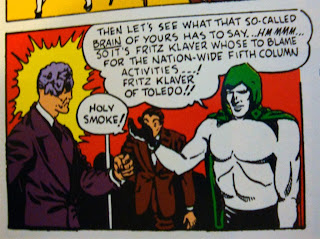Prior to that review, I had examined just one other Durango Kid film-- the 1952 KID FROM BROKEN GUN, the last in the long-running series. I pointed out that BROKEN GUN had only one uncanny aspect, which is also the case with the other three films:
In almost all ways GUN is a naturalistic western like hundreds churned out by the studios of the time. Nothing except the "outre outfit" of the Durango Kid moves it into the domain of the uncanny-metaphenomenal. But as I've noted elsewhere, particularly my review of this "Lone Ranger" film, the hero's mask in this sort of film becomes more than just a mundane device, as it is for some of the villain's hirelings, who also go about masked with bandannas for a few minutes. Though I doubt that I'll ever see the majority of these outlaw-chasing oaters, I'd tend to classify them all as metaphenomenal works. The scene in which the black-clad masked man threatens the villain with execution gives that scene a touch of the uncanny that one would never get from a similar threat made by Gene Autry.
However, even though I insist on this same formalism in my interpretation of other "oaters" in this series, when I reviewed the other three I had to admit they made less impressive use of their metaphenomenal potential.
By saying that [the statement re: Durango as executioner], I didn't mean to suggest that a given Durango Kid would not fit my category of "the uncanny" unless it conveyed such an emotion. The only reason to regard these films as metaphenomenal is based on the POTENTIAL to create such emotions, not in the actual execution. Though the masked western-hero of this series never became a name to conjure with, along the lines of the Lone Ranger-- or even Marvel's "Two-Gun Kid"-- his masked persona removes him from the rank and file of oater-heroes like Roy Rogers and the rest, irrespective as to whether the filmmakers do anything with the potential.
As I emphasized above, a naturalistic western hero, such as Roy Rogers could have played, could have threatened a villain with death, and in that situation such a scene in this hypothetical Autry-film would be dominated by the affect of fear. The scene in BROKEN GUN is dominated by the affect of dread because the Durango Kid's masked persona, even though he's making the same physical threat, carries a symbolic valence that a commonplace cowpoke does not. The other three "Durango films" that I reviewed did not USE the symbolic potential of the masked persona, but it was potentially within the grasp of the scripters, regardless of what they chose to do with it.
Given that I've set up a hypothetical Roy Rogers flick to represent the dominant affect of fear, and a particular Durango Kid film to represent the dominant affect of dread, for symmetry's sake I'll show what kind of awe-inspiring affect is possible when the hero can use a plurality of marvelous powers in order to manipulate the ungodly.



No comments:
Post a Comment